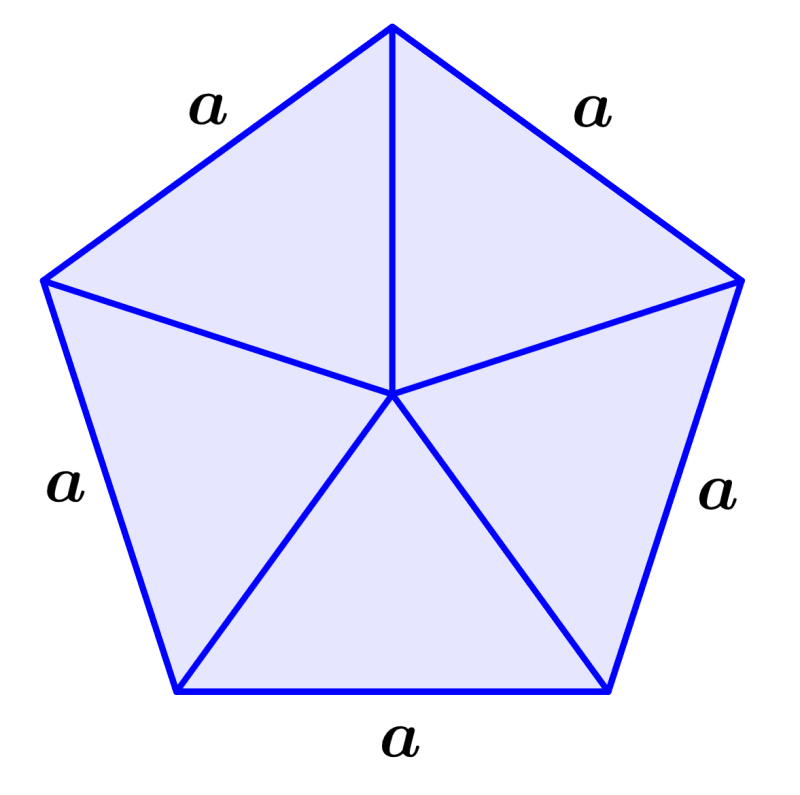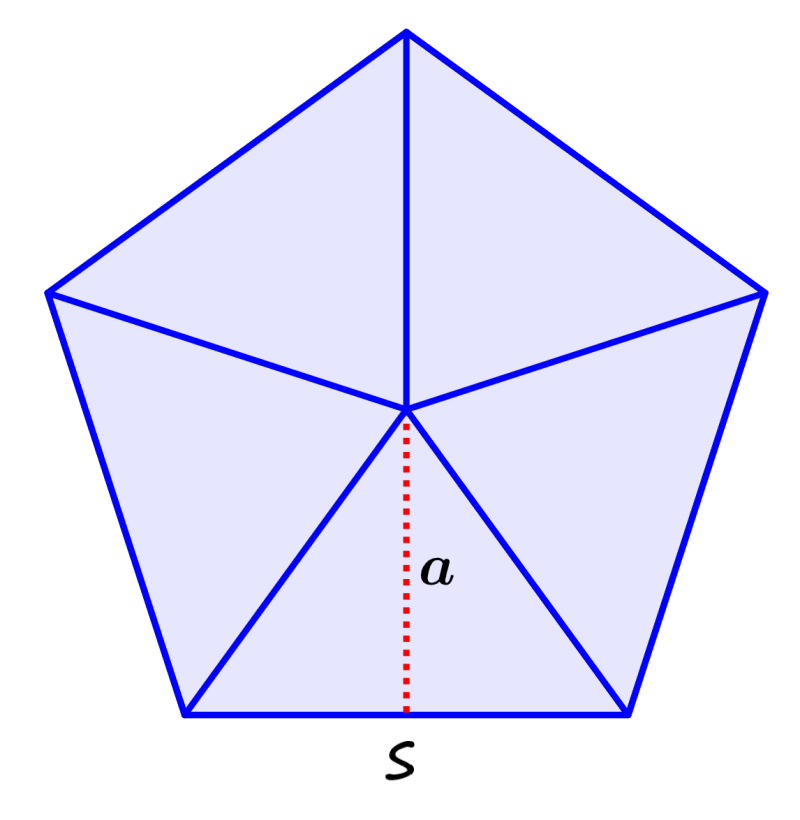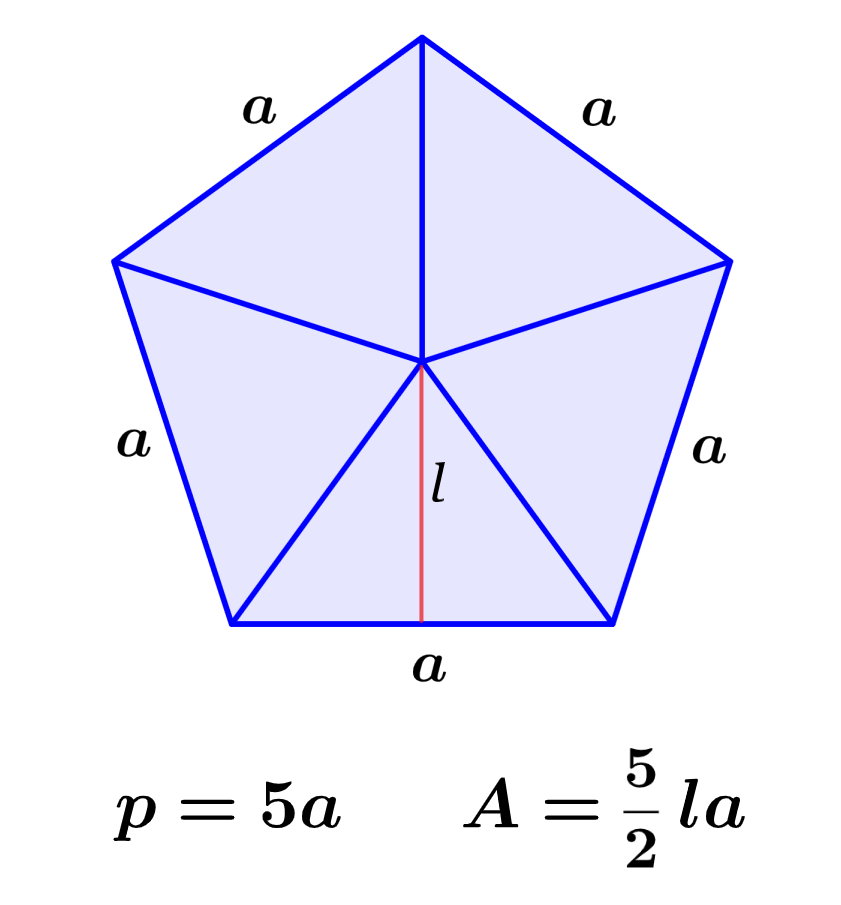The perimeter of a pentagon is the length of the outline of the pentagon. On the other hand, its area represents the two-dimensional space occupied by the figure. We can find the perimeter of a pentagon by adding the lengths of its five sides, and we can find its area by multiplying the length of the apothem by the length of one of its sides and multiplying by 5/2.
In this article, we’ll explore all things related to the perimeter and area of a pentagon. We will explore its formulas and apply them to solve some practice problems.
How to find the perimeter of a pentagon?
The perimeter of a pentagon represents the total length of the pentagon’s boundaries. Therefore, we can calculate the perimeter of a pentagon by adding the lengths of its five sides:
$latex p=a+b+c+d+e$
where, $latex a,~b,~c,~d,~e$ are the lengths of the sides of the pentagon.
If the pentagon is regular, all five of its sides have the same length, so the formula for the perimeter becomes:
| $latex p=5a$ |
where, a is the length of one of the sides of the pentagon.

How to find the area of a pentagon?
The area of a regular pentagon can be calculated using the length of its apothem and the length of one of its sides. Therefore, we can use the following formula:
| $latex A= \frac{5}{2} \times s \times a$ |
where s is the length of one of the sides and a is the length of the apothem. Let us remember that the apothem is the segment that joins the center of the pentagon with one of its sides.
Alternatively, we can calculate the area of a pentagon using the following formula:
| $latex A=\frac{1}{4}\sqrt{5(5+2\sqrt{5}){{s}^2}}$ |
where, s is the length of one of the sides of the pentagon. This formula is more complicated, but it allows us to calculate the area of a regular pentagon simply with the length of one of its sides.
Proof of the formula for the area of a pentagon
To prove the formula for the area of a pentagon, we are going to use the following diagram, where we divide the pentagon into five isosceles triangles as in the following image:

The area of any triangle can be calculated using the formula $latex A= \frac{1}{2} bh$, where b is the base of the triangle and h is its height. In the isosceles triangles above, the base is equal to the length of one of the sides of the pentagon (length s.)
The height of the triangle is equal to the apothem of the pentagon (length a). Therefore, the area of each triangle in the pentagon is $latex A= \frac{1}{2} la$. Since we have five triangles, the area of the pentagon is:
$latex A= \frac{5}{2} \times s \times a$
Area and perimeter of a pentagon – Examples with answers
EXAMPLE 1
Find the perimeter of a regular pentagon that has sides with a length of 10 inches.
Solution
We are going to use the perimeter formula with the value $latex a=10$. Therefore, we have:
$latex p=5a$
$latex p=5(10)$
$latex p=50$
The perimeter of the pentagon is equal to 50 in.
EXAMPLE 2
Find the area of a regular pentagon that has sides with a length of 10 inches and an apothem with a length of 6.88 in.
Solution
We have the following lengths:
- Sides, $latex s=10$ in
- Apothem, $latex a=6.88$ in
Substituting these values into the formula for the area of a pentagon, we have:
$latex A= \frac{5}{2}sa$
$latex A= \frac{5}{2}(10)(6.88)$
$latex A=172$
The area of the pentagon is equal to 172 in².
EXAMPLE 3
Find the perimeter of a regular pentagon that has sides with a length of 11 feet.
Solution
We use the length $latex a=11$ in the formula for the perimeter, and we have:
$latex p=5a$
$latex p=5(11)$
$latex p=55$
The perimeter of the pentagon is equal to 55 ft.
EXAMPLE 4
What is the area of a regular pentagon that has sides with a length of 8 inches and an apothem with a length of 5.51 inches?
Solution
We have the following lengths:
- Side, $latex s=8$ in
- Apothem, $latex a=5.51$ in
Applying the formula for the area with these lengths, we have:
$latex A= \frac{5}{2}sa$
$latex A= \frac{5}{2}(8)(5.51)$
$latex A=110.2$
The area of the pentagon is equal to 110.2 in².
EXAMPLE 5
What is the perimeter of a regular pentagon that has sides with a length of 15 yards?
Solution
We use the formula for the perimeter with the length $latex a=15$. Therefore, we have:
$latex p=5a$
$latex p=5(15)$
$latex p=75$
The perimeter of the pentagon is equal to 75 yd.
EXAMPLE 6
Find the apothem of a regular pentagon that has an area of 84.3 ft² and the length of its sides is 7 ft.
Solution
We have the following:
- Area, $latex A=84.3$ ft²
- Sides, $latex s=7$ ft
In this case, we know the area of the pentagon, and we want to find the apothem. Therefore, we use the information given in the formula for the area and solve for a:
$latex A= \frac{5}{2}sa$
$latex 84.3= \frac{5}{2}(7)a$
$latex 168.6=(5)(7)a$
$latex 168.6=35a$
$latex a=4.82$
The length of the apothem is 4.82 ft.
EXAMPLE 7
If the perimeter of a regular pentagon is equal to 20 yards, what is the length of one of its sides?
Solution
Here, we know the perimeter of the pentagon, and we need to find the length of one of the sides. Therefore, we use the perimeter formula and solve for a:
$latex p=5a$
$latex 20=5a$
$latex a=4$
The length of one side of the pentagon is 4 yd.
EXAMPLE 8
Find the area of a regular pentagon that has sides with a length of 5 inches.
Solution
In this case, we only know the length of the sides of the pentagon and not its apothem. Therefore, we can use the second formula for the area of a pentagon:
$latex A= \frac{1}{4}\sqrt{5(5+2\sqrt{5}){{s}^2}}$
$latex A= \frac{1}{4}\sqrt{5(5+2\sqrt{5}){{(5)}^2}}$
$latex A=43.01$
The area of the pentagon is equal to 43.01 in².
EXAMPLE 9
If the perimeter of a regular pentagon is equal to 105 feet, find the length of one of its sides.
Solution
Let’s use the formula for the perimeter and solve for a. Therefore, using the value $latex p=105$, we have:
$latex p=5a$
$latex 105=5a$
$latex a=21$
The length of one of the sides is 21 ft.
EXAMPLE 10
Find the area of a regular pentagon that has sides with a length of 20 inches.
Solution
Using the second formula for the area with the length $latex s=20$:
$latex A= \frac{1}{4}\sqrt{5(5+2\sqrt{5}){{s}^2}}$
$latex A= \frac{1}{4}\sqrt{5(5+2\sqrt{5}){{(20)}^2}}$
$latex A=688.19$
The area of the pentagon is equal to 688.19 in².
Area and perimeter of a pentagon – Examples with answers
See also
Interested in learning more about perimeters and areas of geometric figures? Take a look at these pages:




